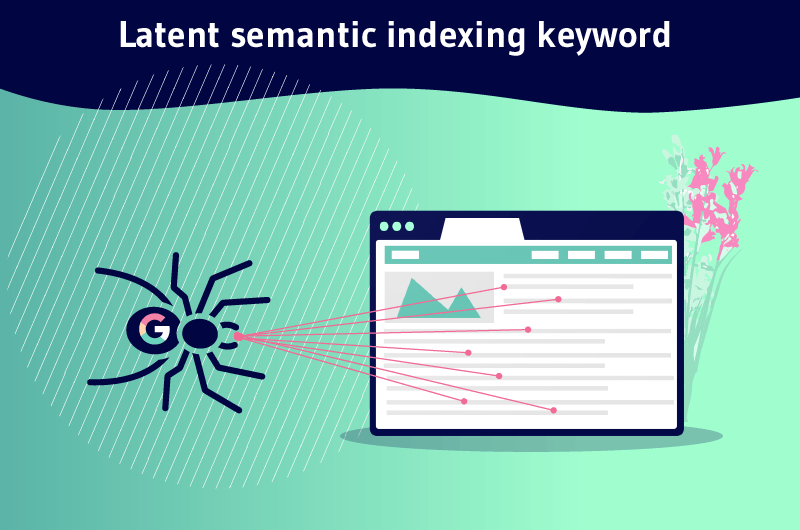Latent Semantic Indexing (LSI) keywords are a set of words that are not synonymous, but that reinforce the main keyword and allow search engines to understand a content in depth. Simply put, they are closely related words that allow search engines to determine what a web page is about. They are based on latent semantic indexing which is the method by which search engines manage to organize web pages. This method tries to understand the semantic links between the words in a text and the main keyword and how they go together
To appear in the first results of search engines remains, for a long time, one of the principles to succeed on the Internet. To achieve this, web content creators employ a variety of methods to increase traffic to their sites.
There is a potentially effective technique for SEO of websites. It is the use of LSI keywords in web pages.
However, the SEO community does not agree on the positive effects of LSI keywords on the ranking of websites by search engines. This raises the following questions:
- What are LSI keywords?
- How do LSI keywords work?
- What is the impact of ISL keywords on the SEO of web pages?
In this article, we will provide some answers to the above questions in order to better understand ISL keywords.
Chapter 1: What are ISL keywords
LSI keywords are actually the consequence of a specific method used by search engines to better understand the contents
This method is called Latent Semantic Indexing and allows search engines to organize information in a semantic structure. Indeed, search engines seek to understand the semantic links between a keyword and a single word when they are used together in a content

This set of words is nothing more than the LSI keywords. To understand LSI keywords, let’s first look at the concept of Latent Semantic Indexing (LSI).
1.1 What do we need to know about LSI?
1.1.1. A brief definition of LSI
LSI is a technique used by search engines to understand how a single word and a keyword in a text go together to mean the same thing.
These words may not be synonyms, but may share some association (visible or not) in the order of succession. We talk about the organization of contents by semantic structure.

To better understand, let’s define the different terms of SIF.
- Indexing: organizing a set of documents to facilitate the search for content in this collection
- Semantic: link between words
- Latent: invisible
Through these definitions, we can easily define ISL as a method of organizing web pages based on invisible links between words in a text.
1.1.2. How does LSI work?
The principle of the organization of web pages by LSI is done through a series of mathematical equations called Singular Value Decomposition (SVD).
SVD is a matrix operation that consists in reducing a text to its constituent parts. This makes it easy to analyze a text and is very practical.
The analysis of the text is done by SIF which removes common verbs, pronouns and conjunctions called “stop words”. Thus, the main words that give meaning to the sentence are isolated.
These words are then used in a Terminology Document Matrix (TDM) that inventories the frequency of use of each word in a set of texts.
From these inventoried words, search engines look for the web pages in which each of these words is found. Then, they analyze the contexts in which these words are used in the different web pages.
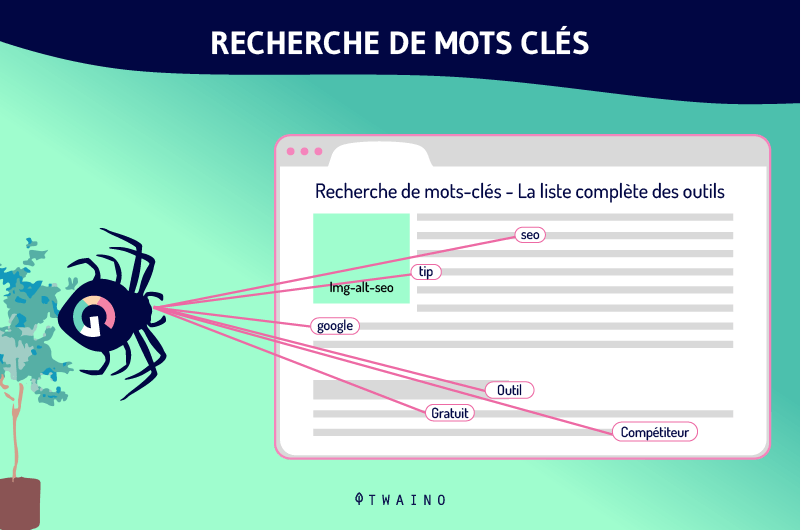
This analysis of the context of use makes it possible to establish the (invisible) relationships between the words and the main keyword.
Finally, SIF uses these relationships to understand the topics covered in the web pages and to organize them. In short, ISL extracts a concept from a set of texts by establishing the links between words that appear in a similar context.
This method of content processing allows search engines to rank web pages based on semantic structure instead of keywords
SIF is able to analyze a large number of documents and is also applicable to a small number of documents.
1.2. Latent Semantic Indexing keywords: what is it really about?
1.2.1. What are LSI keywords?
Search engines are becoming smart enough these days to detect the contexts in which words are used in a content and their relationship with the keywords.
For this purpose, search engines use words that share the same lexical field or that are used in a similar context as to understand a content.
Thus, words that are often used together and in similar contexts constitute SIF keywords.
For example, “bank” and “image” are LSI keywords because they are often used together and in the same context. However, they are not synonymous words.
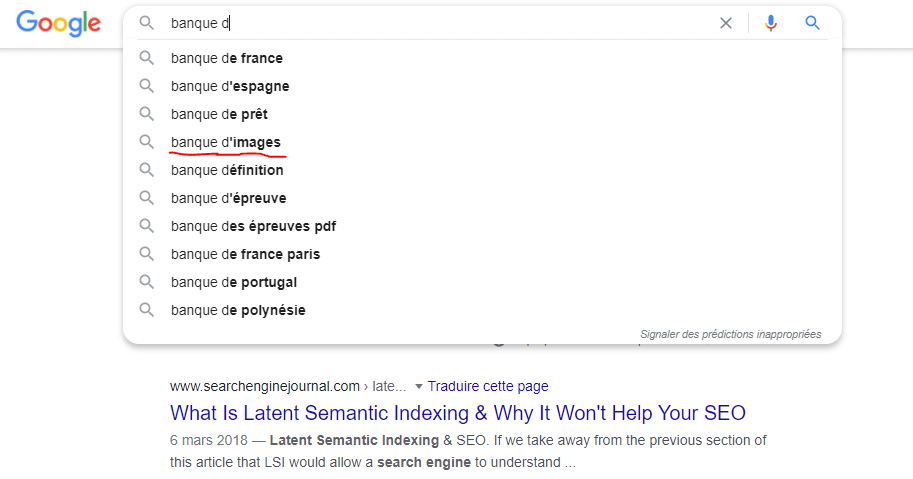
In other words, when a web page or a blog post talks about “bank”, search engines look for LSI keywords to find out if it is a financial institution or a photo library.
However, the difference is obvious if a web page contains “investment bank” or “image bank”.
This shows that the LSI keywords (context of their use and the links between the words) allow search engines to effectively understand the content of a web page.
1.2.2. Why should we be interested in LSI keywords ?
In the past, search engines relied on keywords to match a page to a query. The relevance of a web page was therefore judged by the density of keywords in the page.
Thus, web pages were filled with keywords to get a good ranking in search engines. This practice called “keywords stuffing” led search engines to improve their methods of processing information.

Google for example, began to be suspicious of the density of keywords contained in a web page. The keyword stuffing in the pages does not influence positively the web pages.
Also, the words with which users launch a query are often not those with which the information sought is indexed.
On the other hand, LSI keywords help search engines to understand a web page. Thus, search engines improve search results.
Chapter 2 : How do LSI keywords work ?
The use of LSI keywords becomes without doubt an alternative to the abusive use of keywords in web pages. Indeed, taking into account the unique context of the use of a word makes it possible to adapt the search results to the intention of the use
But before you start using LSI keywords, you need to know how to find them and how to use them.
2.1.some tools for creating LSI keywords
Web content creators can establish LSI keywords themselves. However, there are some tools that can be used to easily create LSI keywords. Among these methods, we find Google Autocomplete and some keyword generator sites.
As far as Google Autocomplete is concerned, it is an easy to use and affordable method
It consists in choosing a main keyword and putting it in the Google search bar.
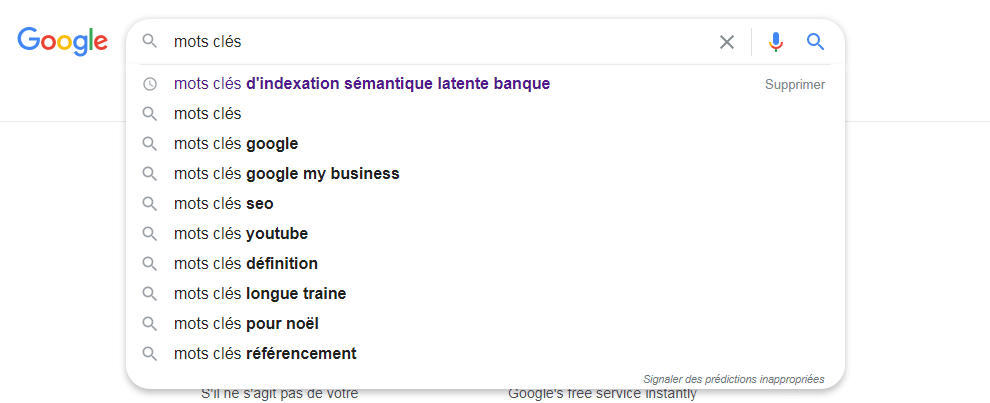
The search engine instantly suggests expressions or phrases that best match the main keyword. These proposals are similar to the word and constitute the LSI keywords.
In addition to Google Autocomplete, the search suggestions at the bottom of the search results are also LSI keywords.

In addition, we have LSI keyword generators that allow you to start from a main keyword and find words that are used in similar contexts.
For example, LSI Graph allows you to identify a few related words to use in a web page. To do so, simply place a main keyword in the search bar and click on “Generate”

LSI Graph then generates a list of suitable keywords as follows:
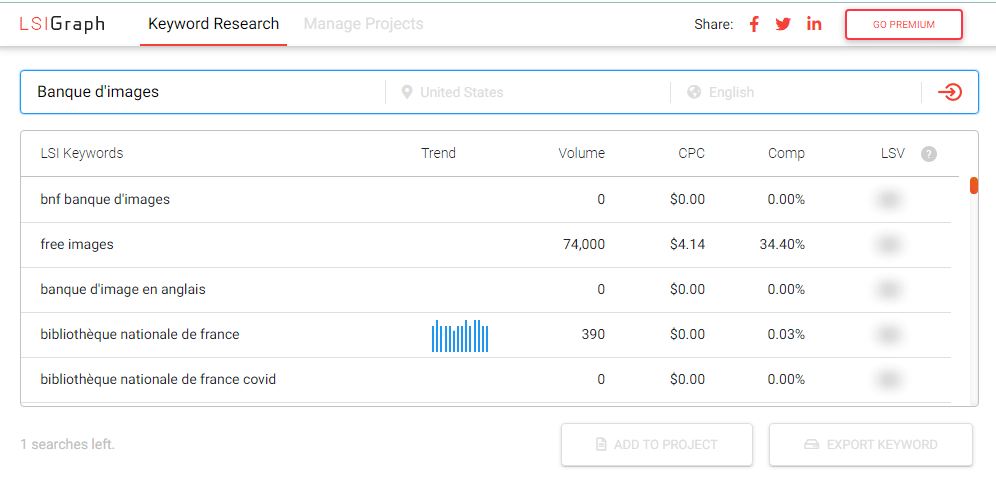
We also have Niche Laboratory which provides not only LSI keyword suggestions, but also web page titles and web site meta descriptions. As an example, let’s search for LSI keywords for the keyword “Investment Bank”.
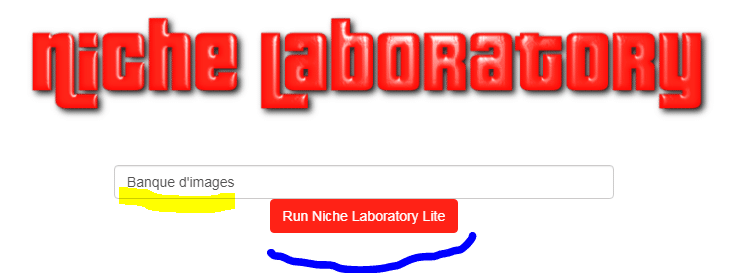
We obtain the following LSI keywords:
In addition, we also find Answer The Public which is based on the same principle.
2.2. how to use LSI ?
The use of LSI keywords cannot be improvised. To be effective, you must know how to place them in the main parts of your page. To begin with, you can first insert the main keyword in the page titles.
Then, try to place the keywords throughout the body of the text in a reasonable manner.
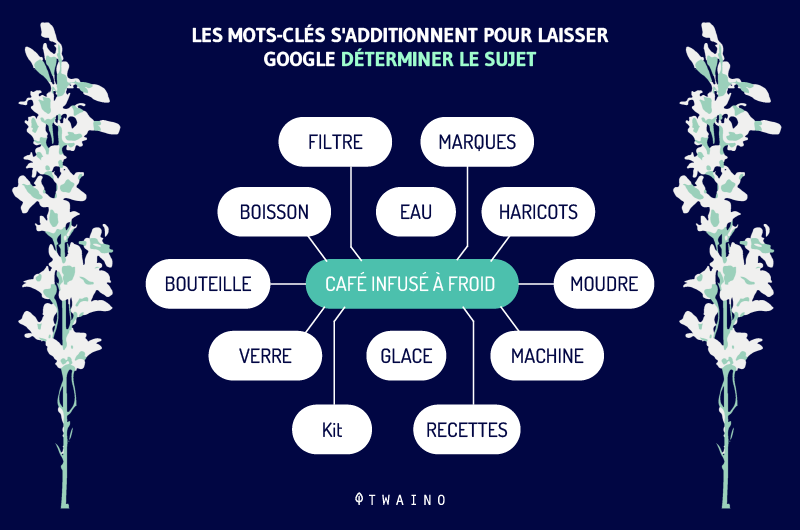
However, it is essential not to abuse the use of LSI keywords in a web page so that search engines do not consider them as keyword stuffing and sanction your page.
Chapter 3 : The advantages and limitations of LSI keywords
The concept of LSI keywords raises a fundamental question, that of the advantages that keywords offer
On the other hand, this concept raises some controversies. Thus, the use of LSI keywords is not unanimous within the SEO community. In this chapter, we will discuss the advantages of LSI keywords and their limitations.
3.1) What are the advantages of using LSI keywords?
The use of LSI keywords has advantages both for the SEO of a web page and for the user experience.
Firstly, the use of varied and semantically related terms to the main keywords increases the relevance of the content of a page. It saves you from high bounce rates and prevents your web page from being ranked for the wrong terms.
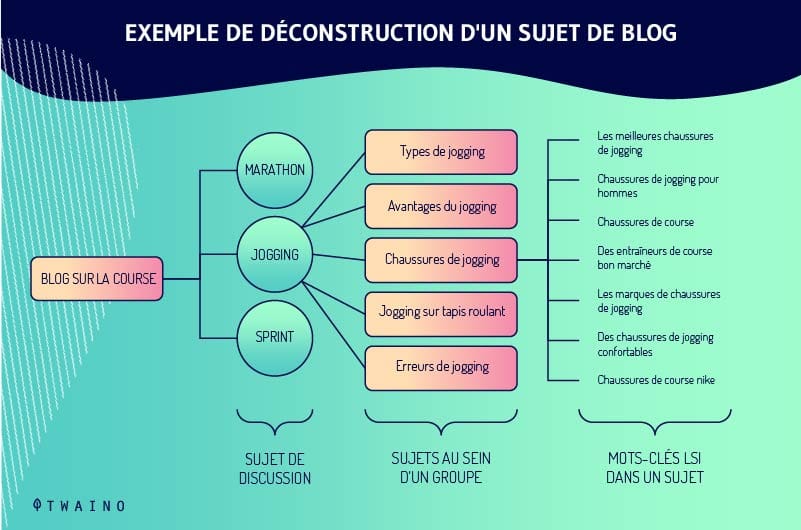
Second, LSI keywords make your page’s content flow natural and meaningful and retain visitors.
Third, keywords improve your web page’s search engine ranking. This is because your page accommodates all searches based on a set of related words and used in similar contexts.
Fourth, LSI keywords positively impact your bottom line by ranking higher than your competitor in search engines. As an example, Amazon records 57 % of its sales are generated by LSI keywords.
3.2. The limits of SIFs
3.2.1. Controversies around SIFs
Given the advantages of using LSI keywords, some content creators overestimate their impact on SEO. However, the benefits of LSI keywords on website SEO are not officially established.
First of all, LSI was created in 1980 essentially for the processing of a few thousand documents. But the advent of the World Wide Web has upset this state of affairs with a vast and very dynamic environment of over of more than one billion of web pages.
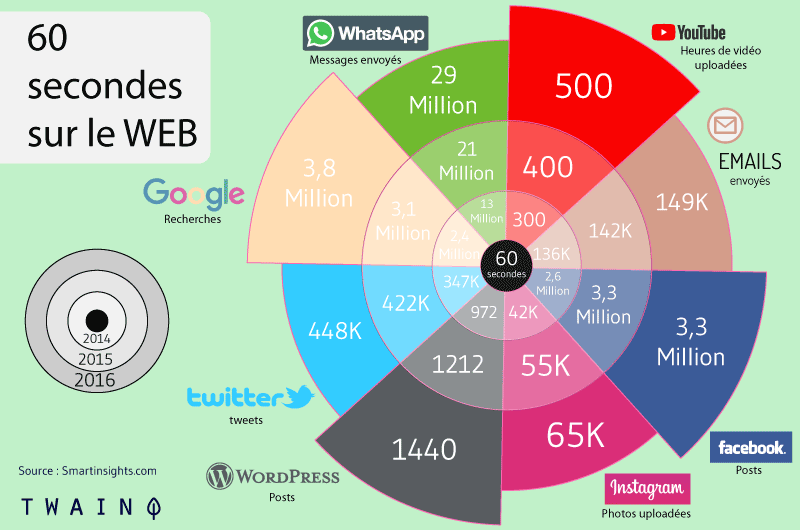
Search engines adapt to this dynamism and regularly change the index of web pages thanks to advanced technologies. Indexing web pages based on similar words like LSI keywords would pose the problem of relevance of search results.
Let’s consider that a web user makes a specific query on “car”. A page that uses related words like car and park will be less relevant than one that uses only the keyword “car”.

The same is true for polysemous words or words that have several meanings. These words do not help search engines understand web pages
Indeed, the LSI considers that words have only one meaning and the technique does not take into account the locutions and can be wrong when a word is used in an ironic context.
On the other hand, the senior analyst of webmaster trends at Google John Muller believes that
“There is no such thing as LSI keywords. Anyone who tells you otherwise is wrong, sorry.
3.2.2. Do search engines really use LSI in query processing?
To begin with, there is no formal evidence that search engines use LSI and consider LSI keywords.
Yandex for example, does not use the LSI method to organize web pages.
As for Google, the search engine has its own algorithm for indexing pages. It is called Word2Vec
According to Bill Slawski
“Google does try to index synonyms and other word meanings. But it doesn’t use LSI’s technology to do so“.
While the processing of information by LSI is interesting, this is not a reason for Google to use it absolutely. That said, we know how much the concept of semantics is important to Google.
Summary
It is worth remembering that LSI keywords are words that share the same lexical field and are often used together in a given context.
They facilitate the treatment of web pages by search engines and allow them to better understand the pages for a good ranking. Thus, they appear interesting for the referencing of websites.
Although the effects of LSI keywords on SEO are not measurable and certain, their use does not harm your SEO
Thus, using LSI keywords is not the ultimate approach to solving your website’s SEO problem, but it is one of the many ingredients that can help your website take off.

